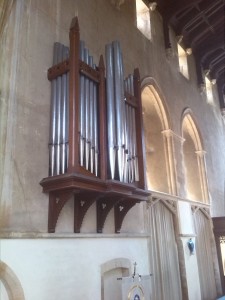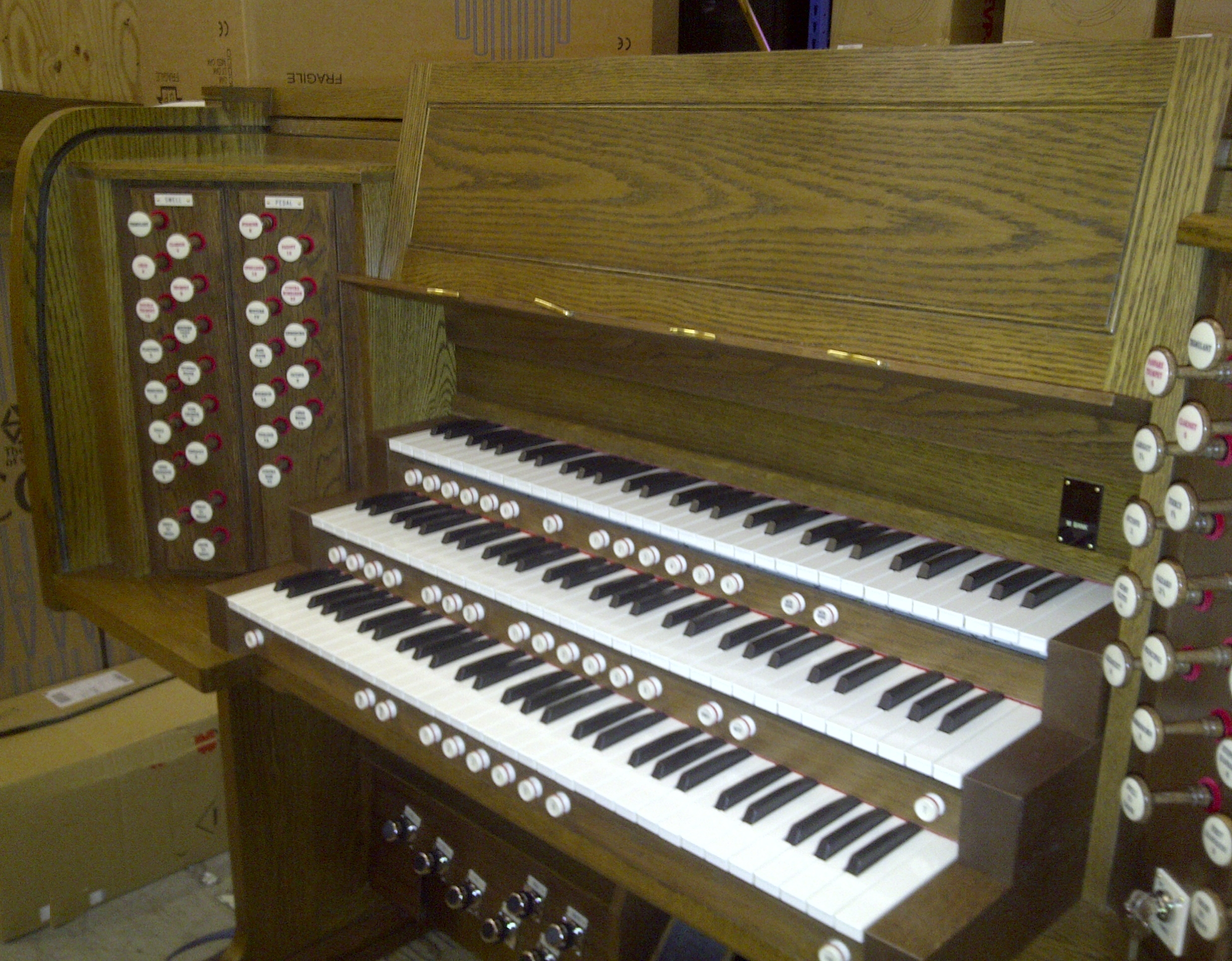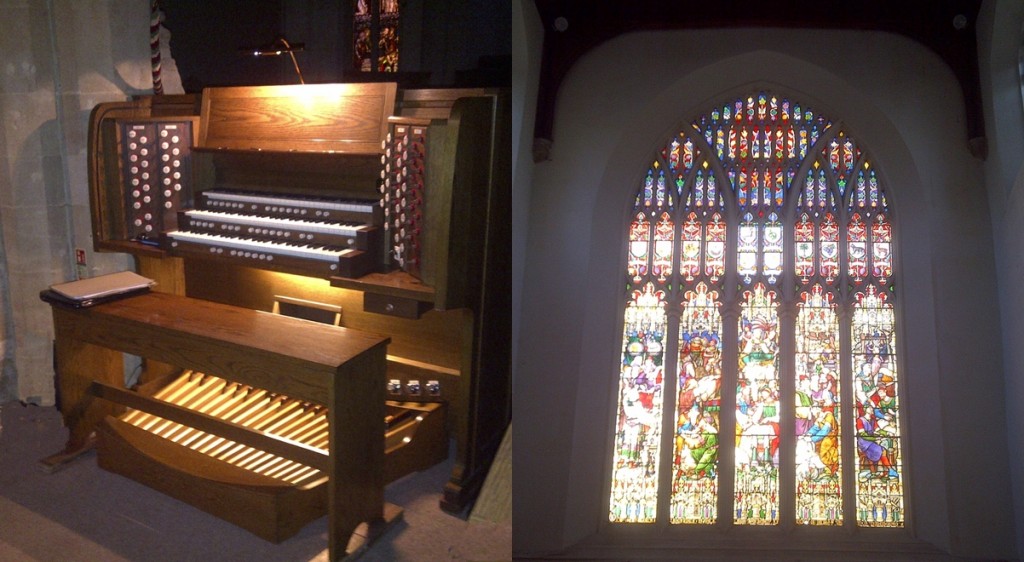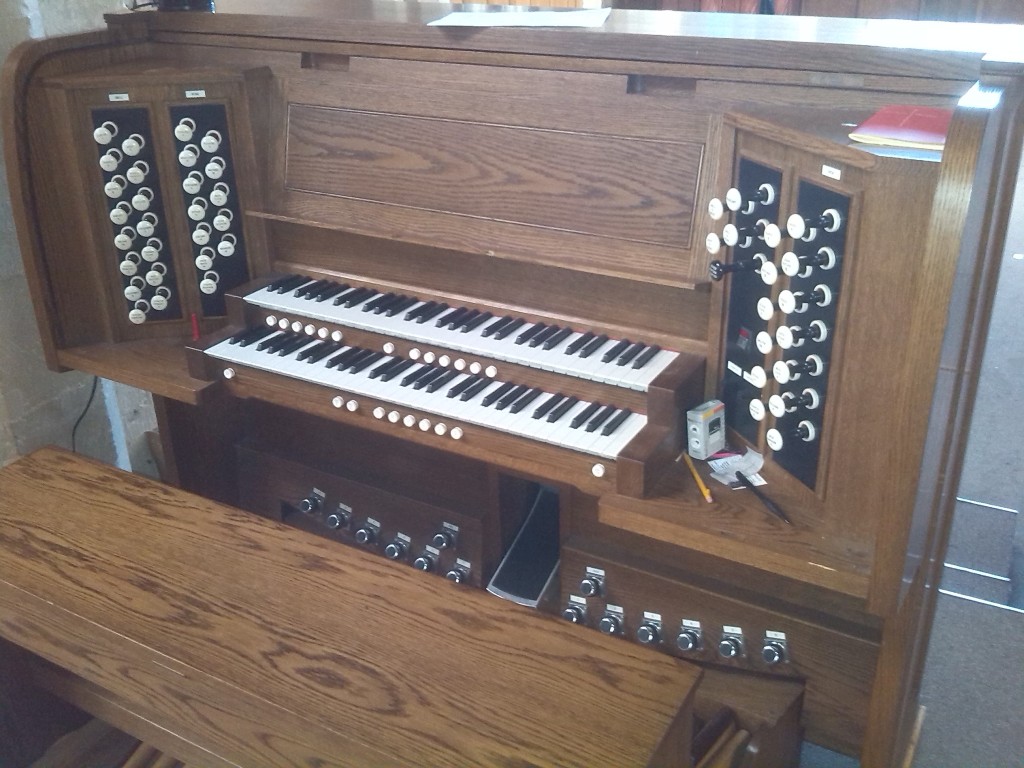The main and civic church for the town of Witney, Saint Mary’s, was re-dedicated in 1243. The church sits in a prominent position at the head of the town green with a substantial spire above the crossing. The fine west window (and our reworked console) can be seen at the top of this page. The pipe organ once located in an alcove on the south side of the choir was replaced by a Bradford computing organ in the early 1990s.
A project to raise funds to rebuild this organ using current digital organ technology had been started in 2013, but in 2014 the console interior suffered an electrical fault during a choral evensong, resulting in a certain amount of smoke. While this might have been a problem familiar to organists when the only lighting was from candles, it is most unusual in modern times. The organ was condemned as unsafe, and the event “lit a fire” under the fund-raising efforts. We were asked to provide an estimate to build a new 3 manual organ (the old one was only 2 manual) in the original console. A faculty was issued in late October of 2014 and we began the rebuild shortly before Christmas.
We had assumed that the old console (pictured left) was originally intended to house 3 manuals as it was very large for a 2 manual instrument. Detailed measurement back at the workshop revealed this was not the case as the knee board carrying swell pedal and toe pistons was correctly positioned for 2 manuals. It was necessary therefore to move this substantial structural part of the console and the economics of reusing the console were probably finely balanced because of this.
 The outgoing organ had for its day, a very convincing sound and substantial presence in the building, especially at the bass end. The excellent acoustics of the church and the speaker location were a major asset in this respect. A purpose made dummy pipe case had been constructed on the south aisle at the crossing, containing all the speakers including, as we later found three purpose made bass cabinets, each with two 10 inch drivers. All the amplification equipment was also in the pipe case with just 5 signal cables going back to the console. This meant any servicing or repair that might be required would be difficult as access would need scaffolding and removal of the façade pipes and some of the speakers. Not an easy job at all.
The outgoing organ had for its day, a very convincing sound and substantial presence in the building, especially at the bass end. The excellent acoustics of the church and the speaker location were a major asset in this respect. A purpose made dummy pipe case had been constructed on the south aisle at the crossing, containing all the speakers including, as we later found three purpose made bass cabinets, each with two 10 inch drivers. All the amplification equipment was also in the pipe case with just 5 signal cables going back to the console. This meant any servicing or repair that might be required would be difficult as access would need scaffolding and removal of the façade pipes and some of the speakers. Not an easy job at all.
With the new installation we decided that all amplifiers would be inside the organ console to allow for easy access if needed. This required heavier duty cable to run to the speakers. The new organ was spread onto 14 audio channels. The cable routes finally chosen by the church architect required routes being arranged under the floor below the tower, this work being undertaken directly by St Mary’s.
Our rebuilt instrument (specification below) seen here in the workshop was installed in January 2015 and apart from an issue with the pedal board, which we had reused from the original instrument, played perfectly first time. Those of you familiar with the circuit mapping for keyboards and pedal boards will know that a group of just 12 wires is needed to manage the 32 notes of a pedal board. The old Bradford
 logic was not quite the same as Viscount logic of 2015 so there was always a risk that the pedal board would not initially communicate correctly with the organ and this was the case. A simple interface resolved the problem and next day all was well. The new console was fitted with new draw stops and new wood based keyboards. 12 new speakers were installed in the old pipe enclosure including two of the original bass cabinets fitted with new long-throw 10 inch drivers. Some of the swell speakers were put at the top of the enclosure and pointed up to the roof to provide a more diffuse radiation of the reed stops. The speakers carrying the new choir division are concealed high behind the chancel alcove arch, in the location of the original pipe organ, so the sound reflects into the choir off the alcove back wall. You can listen to the organ below (First Movement of Widor’s 6th Organ Symphony).
logic was not quite the same as Viscount logic of 2015 so there was always a risk that the pedal board would not initially communicate correctly with the organ and this was the case. A simple interface resolved the problem and next day all was well. The new console was fitted with new draw stops and new wood based keyboards. 12 new speakers were installed in the old pipe enclosure including two of the original bass cabinets fitted with new long-throw 10 inch drivers. Some of the swell speakers were put at the top of the enclosure and pointed up to the roof to provide a more diffuse radiation of the reed stops. The speakers carrying the new choir division are concealed high behind the chancel alcove arch, in the location of the original pipe organ, so the sound reflects into the choir off the alcove back wall. You can listen to the organ below (First Movement of Widor’s 6th Organ Symphony).
You can read what Francis has to say about the process of selecting Viscount for the replacement instrument.
The new instrument in its older console, but now with 3 manuals, looks very comfortable in its original position under the crossing. Francis Rumsey the organist put many hours of time into the planning and specification of the instrument and without his help and enthusiasm this project would not nearly have run so smoothly.
Francis is an unusually tall organist as you may just gather from the picture of him at the new console. One modification made especially for him was to raise the height of the console to provide a little extra distance from underside of keyboards to pedal board, so while this is actually in the strict sense a rebuild of the existing organ, it was tailor made to fit the particular needs of the principal organist.
| Pedal 12 | Great 13 | Swell 12 | Choir 10 | ||||
|---|---|---|---|---|---|---|---|
| Contra Bass | 32 | Double Diapason | 16 | Open Diapason | 8 | Gemshorn | 8 |
| Open Wood | 16 | Open Diapason I | 8 | Gedackt | 8 | Gedackt | 8 |
| Violone | 16 | Open Diapason II | 8 | Viola | 8 | Principal | 4 |
| Bourdon | 16 | Claribel Flute | 8 | Voix Celeste | 8 | Rohr Flute | 4 |
| Octave | 8 | Stopped Diapason | 8 | Principal | 4 | Nazard | 2-2/3 |
| Bass Flute | 8 | Octave | 4 | Stopped Flute | 4 | Octave | 2 |
| Gemshorn | 4 | Harmonic Flute | 4 | Flautino | 2 | Tierce | 1.3/5 |
| Mixture 19 22 26 29 | IV | Twelfth | 2.2/3 | Mixture 15 19 22 26 | IV | Larigot | 1.1/3 |
| Contra Bombarde | 32 | Fifteenth | 2 | Double Trumpet | 16 | Clarinet | 8 |
| Opheclide | 16 | Mixture 19 22 26 29 | IV | Trumpet | 8 | Fanfare Trumpet | 8 |
| Fagott | 16 | Double Trumpet | 16 | Oboe | 8 | ||
| Trumpet | 8 | Trumpet | 8 | Clarion | 4 | ||
| Clarion | 4 | ||||||
| Great to Pedal | Swell to Great | Tremulant | Tremulant | ||||
| Swell to Pedal | Choir to Great | Swell to Choir | |||||
| Choir to Pedal | Gt & Ped Pistons combined | ||||||
I have had a passion for church organs since the tender age of 12. I own and run Viscount Organs with a close attention to the detail that musicians appreciate; and a clear understanding of the benefits of digital technology and keeping to the traditional and emotional elements of organ playing.





